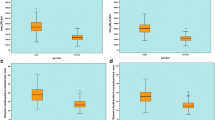Abstract
Assessments of oedema and decrease in hand strength are useful for patients with a hand lesion. This study examined the asymmetry of the arms and determined the estimates of the unknown prior to lesion values for hand volume, grip strengths assessed with a Jamar dynamometer (GSJ) and a Collins dynamometer (GSC), and pinch strength with a Jamar pinch gauge (PS) in 100 healthy working people. Hand volume, GSJ, GSC, and PS of the dominant hand were respectively 3.6 ± 4.1%, 6.6 ± 9.2%, 11.7 ± 11.2%, and 8.0 ± 13.2% higher than those of the non-dominant hand (p < 0.001). Very good estimates were obtained with the values of the contralateral arm for all the indices studied. The correlation coefficient equalled 0.95 for hand volume, 0.91 for GSJ, 0.83 for GSC, and 0.72 for PS. These estimates allow us to evaluate the evolution of oedema and hand strengths in patients with hand injury, especially to determine whether they could return to work as they are mostly manual workers with demanding jobs.
Similar content being viewed by others
References
Caisse Nationale de l'Assurance Maladie des Travailleurs Salariés (CNAMTS). Statistiques financières et technologiques des accidents du travail. Années 1991, 1992, 1993. Paris: CNAMTS, 1995.
Gable C, Chau N, Xénard J, André JM. Accords interjuges d'une mesure fonctionnelle analytique du membre supérieur. Rev Epidemiol Sante Publique 1993; 41: 72–83.
Beverly MC, Rider TA, Evans MJ, Smith R. Local bone mineral response to brief exercise that stresses the skeleton. Br Med J 1989; 299: 233–235.
Tubiana R. Traitéde chirurgie de la main. Tome 1: Anatomie. Physiologie. Biologie. Méthodes d'examen. Paris: Masson, 1980.
Chau N, d'Houtaud A, Gruber M, Monhoven N, Gavillot C, Pétry D, Bourgkard E, Guillaume S, André JM. Personality self-representation of patients with hand injury, and its relationship with work injury. Eur J Epidemiol 1995; 11: 373–382.
Godal R, Swedborg I. A correction for the natural asymmetry of the arms in the determination of the volume of oedema. Scand J Rehab Med 1982; 14: 193–195.
Bednarczyk JH, Hershler C, Cooper DG. Development and Clinical Evaluation of a Computerized Limb Volume Measurement System (CLEMS). Arch Phys Med Rehabil 1992; 73: 60–63.
Petersen P, Petrick M, Connor H, Conklin D. Grip strength and hand dominance: Challenging the 10% rule. Am J Occup Ther 1989; 43: 444–447.
Bechtol CO. Grip test: Use of a dynamometer with adjustable handle spacing. J Bone Joint Surg 1954; 36A: 820–824.
Mathiowetz V, Kashman N, Volland G, Weber K, Dowe M, Rogers S. Grip and pinch strength: Normative data for adults. Arch Phys Med Rehabil 1985; 66: 69–74.
Lunde BK, Brewer WD, Garcia PA. Grip strength of college women. Arch Phys Med Rehabil 1972; 53: 491–493.
Schmidt RT, Toews JV. Grip strength as measured by the Jamar dynamometer. Arch Phys Med Rehabil 1970; 51: 321–327.
Swanson AB, Matev IB, Groot G. The strength of the hand. Bull Prosthet Res 1970; 10: 145–153.
Kellor M, Frost J, Silberberg N, Iversen I, Cummings R. Hand strength and dexterity. Am J Occup Ther 1971; 25: 77–83.
Chau N, Pétry D, Bourgkard E, Huguenin P, Remy E, André JM. Comparison between estimates of hand volume and hand strengths with sex and age with and without anthropometric data in healthy working people. Eur J Epidemiol 1997; 13: 309–316.
Edwards DAW, Hammond WH, Heary NJR, Tanner JM, Whitehouse RH. Design and accuracy of calipers for measuring subcutaneous tissue thickness. Br J Nutr 1955; 9: 133–143.
Cnockaert JC, Pertuzon E. Détermination des constantes biomécaniques d'un segment corporel (avant-brans plus main). I. Mesure du volume et estimation de la masse. Le travail Humain 1970; 33: 37–46.
Gurney JM, Jelliffe DB. Arm anthropometry in nutritional assessment: Nomogram for rapid calculation of muscle circumference and cross-sectional muscle and fat areas. Am J Clin Nutr 1973; 26: 912–915.
Mathiowetz V, Weber K, Volland G, Kashman N. Reliability and validity of hand strength evaluation. J Hand Surg 1984; 9A: 222–226.
Kirpatric JE. Evaluation of grip loss. Calif Med 1956; 85: 314–320.
Fess EE, Moran C. Clinial Assessment Recommendations. Indianapolis: American Society of Hand Therapists, 1981.
Armitage P, Berry G. Statistical methods in medical research. Oxford: Blackwell Scientific Publications, 1987.
Freund RJ, Minton PD. Regression methods. A tool for data analysis, statistics: Textbooks and monographs, Vol 30. New York: Marcel Dekker Inc, 1979.
Chau N, Patris A, Martin J, Kohler F, Lambert JP. Conception d'un logiciel de traitement et d'interrogations statistiques de données Logist. Int J Biomed Comput 1985; 16: 95–118.
Scott PA. Morphological characteristics of elite male field hockey players. J Sports Med Phys Fitness 1991; 31: 57–61.
Maughan RJ, Abel RW, Watson JS, Weir J. Forearm composition and muscle function in trained and untrained limbs. Clin Physiol 1986; 6: 389–396.
Author information
Authors and Affiliations
Rights and permissions
About this article
Cite this article
Chau, N., Remy, E., Pétry, D. et al. Asymmetry correction equations for hand volume, grip and pinch strengths in healthy working people. Eur J Epidemiol 14, 71–77 (1998). https://doi.org/10.1023/A:1007436000228
Issue Date:
DOI: https://doi.org/10.1023/A:1007436000228




